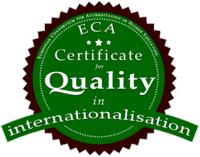The Creative Technology programme aims at graduates who are social problem solvers.
International in all facets

Creative Technology has been awarded the prestigious ECA Certificate for Quality in Internationalisation, true recognition for our efforts of making this programme international in all its facets: the purpose, function and organisation of our education. This means you will not only study in an international environment but you will also be stimulated to incorporate different cultures and perspectives while developing sustainable solutions.
Goal of the study
There is a fading boundary between the natural physical world and the world of (interactive, intelligent, understanding) human constructions. Creative Technology educates designers who are fluent speakers of the languages of both worlds and who can unite the two. We educate designers, in a community of students with different backgrounds, interests and motivation. These designers will be valuable in application areas of any kind.
CreaTe concentrates on “design for the digital world” (game design, web design, interaction design, motion design and motion graphic design, and visual communication).
The engineering goals of Creative Technology cover aspects of Computer Science and Electrical Engineering (programming, web technology, sensors, communicating systems, dynamical systems and system control).
Obviously, Creative Technology aims at applications in Creative Industry and entertainment, but also at cross-overs with other sectors such as healthcare.
Learning, training and persuasion through serious games are equally important. And so is enhancing reality for various purposes, e.g. to stage interaction while participants are at different locations, to create distraction, to create a feeling of well-being, to improve perception, or to improve safety and security. One finds ideas and concepts for enhanced reality in interior design, in architecture, in public space, in health care and in many other areas.
As a Creative Technology graduate you qualify as a designer in the sense of Herbert Simon, who defines design as “a way to improve situations”. A designer needs not only rational and analytical ways of thinking, but also “design thinking”, where emotional and cultural aspects become important. Design thinking often comes up in the context of “experience design.” Experience design is primarily a way of looking at design. It is the practice of designing products, processes, services, events, and environments with a focus placed on the quality of the user experience and culturally relevant solutions. Less emphasis is placed on increasing and improving functionality of the design. Creative Technology is a university programme with ample attention for design thinking and experience design.
Creative Technology aims for graduates who are capable of innovation by the introduction of artefacts for new and sometimes unexpected purposes. New and better use of existing technology is more important than the introduction of new technology. Their creativity concentrates on making life safer, healthier, easier, more exciting or just more fun. They need science, but also an understanding of human behaviour, and affinity with the creation of visual (and other) experience.
